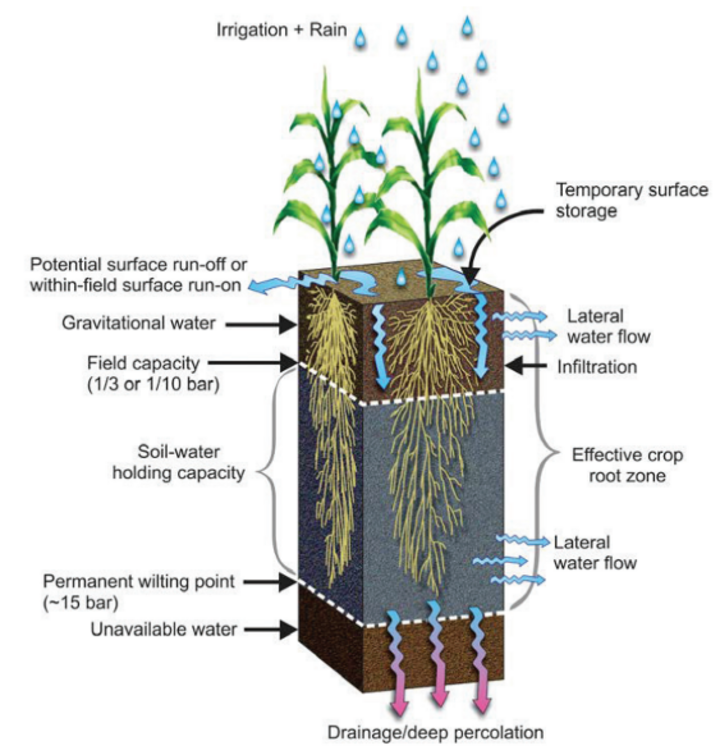Key Takeaways
- Soil holds off-season moisture for getting crops established.
- Little irrigation is needed most years on corn during the vegetative stage to produce top yields. 2023 is the exception to this general rule in many Nebraska fields.
- Excess irrigation in June puts you at risk for losing 5-10 lbs of nitrogen/extra inch.
- Leave room to capture rainfall events.
- Measure soil moisture and ET.
Getting the crop off to a great start is essential for a successful season. On dry years, it is sometimes necessary to start irrigating in May and June. However, it is critical to monitor soil moisture to balance crop needs with the risk of losing nitrogen and other valuable crop inputs. Monitoring will also help prevent unnecessary irrigation expenses, and if you have a water allocation, avoid using up water that is critical for later growth stages.
May and June are particularly vulnerable times for nitrate leaching in our irrigated fields because of several factors. First, the fields are left fairly wet from last season's irrigation, precipitation from October through May usually puts more water into the soil than it can hold, the crop is still small and not using much water, and most — if not all — the nitrogen for the corn crop has been applied.
Strategies for Early Season Irrigation
Last year’s irrigation will have left the soil fairly wet compared to dryland fields. On a typical year, a silt loam soil that was reasonably well irrigated the previously year (full yield) may only hold two to four inches of water from precipitation in the non-growing season. Sandy soils will hold even less. This means most years, irrigated fields will be at or above field capacity in May, particularly in the eastern two-thirds of Nebraska.
Also, keep in mind the corn roots grow about an inch each day into soil that is at field capacity, providing much of the water the plants need for that day. Generally, irrigation needs to be delayed until the soil begins to dry down. Furthermore, research conducted in the North Platte area has shown that irrigation could be reduced by one to four inches, compared to a fully irrigated crop, during the vegetative period without a significant yield reduction and can stimulate deeper root growth. For more information, go to "Vegetative Growth Stage Irrigation, Is It Needed This Year?"
2023’s Exceptional Drought
Reviewing several soil water logs from central Nebraska, many fields were left a little drier than normal after 2022’s harvest. Plus, with many areas of the state getting very little precipitation from October through May, many fields have needed some irrigation to get the crop established and growing well through the vegetative stage. It all depends on the amount of water stored in the soil.
Soil Moisture Monitoring
In this drought year, many irrigated fields have very little subsoil moisture, while other portions of Nebraska have experienced significant rains over the last month. With irrigation, any grower can can over-irrigate early and create a wet spring. The most reliable method to know when and how much to irrigate is to monitor soil moisture at multiple depths. Keep in mind that when irrigation is applied with a center pivot an inch at a time on the soil surface, the top foot will stay very wet all summer.
Soil water monitoring data is easier to analyze once the crop has taken up water at the 16- to 24-inch depth during the vegetative growth stage. This drier zone can then be monitored with sensors to see if the area gets wetter or drier. If it keeps getting drier, the irrigation system needs to keep running. However, if it starts to get wetter, then stop irrigating for a few days. Ideally, the drier zone should slowly expand deeper with the crop using most of the subsoil water by the time the crop matures.
For more information on this scheduling strategy, watch the Advanced Irrigation Scheduling Techniques video.

Risk of Early Season Leaching
Excess irrigation has its own risks. Generally, when the soil is above field capacity, excess water leaves the root zone, called deep percolation. This is an essential function of the soil for groundwater recharge. When deep percolation takes agrichemicals past the root zone, it is called leaching. May and June are the most critical time for leaching losses all year.
Nitrate leaching loss rates typically range from five to 10 pounds of nitrogen for every inch of water lost to deep percolation or drainage in Nebraska (based on in-field research as well as modeling nitrate-nitrogen losses in a Hastings silt loam soil series with over-irrigation during May and June. Source Aaron Daigh, 2023). Leaching losses can be even larger in sandy soil, with values as large as 30 lb/ac for every inch of over-irrigation measured in a loamy sand soil. Over-irrigation is very expensive and something that needs to be avoided.
Leave Room for Storing Rainfall
Monitoring soil moisture and leaving it moderately dry during the vegetative growth states also leaves room for the soil to store any rainfall that may come. Too wet and you’ll lose that rainfall as runoff or deep percolation. Each inch of rainfall you store saves irrigation, input costs and prevents nitrate leaching.

The key to early water management is to apply irrigation only when it is needed to get the crop off to a good start, while keeping in mind over-irrigation enables crop input losses. Precision water and nitrogen management can help guide your early season irrigation decisions.

